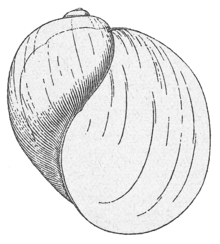Myxas glutinosa
| Myxas glutinosa | |
|---|---|
 | |
| Four shells of Myxas glutinosa, scale bar in cm & mm | |
| Scientific classification | |
| Kingdom: | Animalia |
| Phylum: | Mollusca |
| Class: | Gastropoda |
| (unranked): | clade Heterobranchia clade Euthyneura clade Panpulmonata clade Hygrophila |
| Superfamily: | Lymnaeoidea |
| Family: | Lymnaeidae |
| Subfamily: | Lymnaeinae |
| Genus: | Myxas |
| Species: | M. glutinosa |
| Binomial name | |
| Myxas glutinosa (O. F. Müller, 1774)[2] | |
The glutinous snail, Myxas glutinosa is a species of small air-breathing freshwater snail, an aquatic gastropod mollusc in the family Lymnaeidae, the pond snails.
Anatomy

This snail is unusual in that it extends its almost transparent mantle to completely cover the shell when it is in motion, giving the very small animal a glass-like appearance. It also makes the animal sticky to the touch, hence its common name.
Shell Description
The shell is 13 to 16 mm in height and 11 mm to 15 mm in width in the adult. The upper whorls are almost flat so that the shell has a short blunt spire, the last whorl is inflated and predominating.The aperture is more than 90 % of the shell height. The umbilicus is closed. The shell colour is brown or green, extremely thin and very transparent and shiny.
Distribution
This species is European: it is now rare in western Europe, and even rarer in eastern Europe.
- British Isles - listed in List of endangered species in the British Isles
- This species is fully protected in the United Kingdom under the Wildlife and Countryside Act 1981 since 1981.[3]
- Great Britain - in one locality in Wales[4]
- Ireland - extinct in Northern Ireland, still common in the Royal Canal and Grand Canal in central Ireland[5]
- Czech Republic - extinct in Bohemia[6]
- Germany - critically endangered (vom Aussterben bedroht)[7]
- Netherlands
- Poland
According to the IUCN red list[1] it is also native to Austria, Belarus, Belgium, Estonia, Finland, Germany, Kazakhstan, Latvia, Lithuania, Moldova, Norway, Russian Federation, Sweden and Ukraine.
Habitat
This species requires pollution-free, extremely clear, calm water, in calcium-rich canals, streams and lakes.
It is rapidly declining or already extinct in many European countries, because of the loss of good habitat.
References
- 1 2 Mollusc Specialist Group 1996. Myxas glutinosa. In: IUCN 2008. 2008 IUCN Red List of Threatened Species. <www.iucnredlist.org>. Downloaded on 30 December 2008.
- ↑ Müller O. F. 1774. Vermivm terrestrium et fluviatilium, seu animalium infusoriorum, helminthicorum, et testaceorum, non marinorum, succincta historia. Volumen alterum. pp. I-XXVI [= 1-36], 1-214, [1-10]. Havniae & Lipsiae. (Heineck & Faber).
- ↑ Protection for wild animals on Schedule 5 of the Wildlife and Countryside Act, 1981. website accessed 7 August 2009.
- ↑ Species Action Plan. Glutinous Snail (Myxas glutinosa). accessed 31 December 2008
- ↑ Myxas glutinosa – The glutinous snail. accessed 31 December 2008.
- ↑ (Czech) Horsák M., Juřičková L., Beran L., Čejka T. & Dvořák L. (2010). "Komentovaný seznam měkkýšů zjištěných ve volné přírodě České a Slovenské republiky. [Annotated list of mollusc species recorded outdoors in the Czech and Slovak Republics]". Malacologica Bohemoslovaca, Suppl. 1: 1-37. PDF.
- ↑ Glöer P. & Meier-Brook C. 2003. Süsswassermollusken. DJN, pp. 134, page 107, ISBN 3-923376-02-2.
Further reading
- Green W. A. (1901). "Amphipeplea (Lymnaea) glutinosa in the River Bann". Irish Naturalist 10: 132.
- Vinarski M. V., Grebennikov M. E. & Shishkoedova O. S. (2013). "Past and present distribution of Myxas glutinosa (O.F. Müller, 1774) in the waterbodies of the Urals and Siberia". Journal of Limnology 72(2): 336-342. doi:10.4081/jlimnol.2013.e27.
- Welch R. J. (1900). "Amphipeplea glutinosa Müller, in Ireland". Irish Naturalist 9: 48.
External links
- Myxas glutinosa at Animalbase taxonomy,short description, distribution, biology,status (threats), images
| Wikimedia Commons has media related to Myxas glutinosa. |
